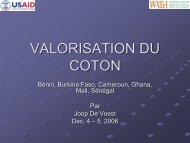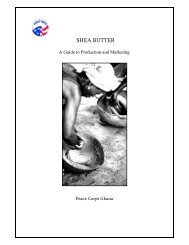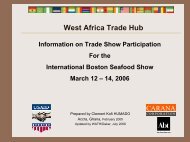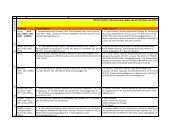A Brief Introduction to Textile Processing - AGOA Export Toolkit
A Brief Introduction to Textile Processing - AGOA Export Toolkit
A Brief Introduction to Textile Processing - AGOA Export Toolkit
You also want an ePaper? Increase the reach of your titles
YUMPU automatically turns print PDFs into web optimized ePapers that Google loves.
lubricants. This is typically by processing the fabric through a trough of enzyme solution, followed by<br />
vigorous washing in hot water. Starch and most other sizings dissolve poorly in plain water; the<br />
enzyme helps degrade the starch.<br />
The<br />
fabric (both woven and knitted) is then typically bleached. This is commonly done by processing<br />
the fabric through a series of one <strong>to</strong> three troughs containing various chemicals, including a strong<br />
oxidizing agent (usually hydrogen peroxide). Chemicals used in bleaching need <strong>to</strong> be s<strong>to</strong>red carefully.<br />
Both hydrogen peroxide and caustic (sodium hydroxide, a commonly used bleaching chemical) are<br />
very dangerous if mishandled. The particular types of processing equipment used will depend on the<br />
type of cloth <strong>to</strong> be processed (woven, knit), and whether the fabric is <strong>to</strong> be printed.<br />
D yeing and / or printing<br />
Dyeing<br />
and printing are the steps that impart color <strong>to</strong> a fabric, making finished products such as<br />
garments much more attractive. Dyeing and printing is highly complex, requiring years of study and /<br />
or experience. Only the highlights will be summarized here.<br />
Dyes<br />
and application methods vary greatly. Colorfastness is the degree <strong>to</strong> which a fabric will retain its<br />
color when subjected <strong>to</strong> adverse conditions such as sunlight, detergent, bleach, or other agents.<br />
Different types of dyes, and different methods of application produce substantially different levels of<br />
clarity and colorfastness. For optimal quality of the fabrics and final products, dye types and<br />
application methods must be carefully selected according <strong>to</strong> the fiber type, fabric type, and expected<br />
end use.<br />
Color<br />
can be imparted at any one of several stages in textile and garment production, from the fiber<br />
<strong>to</strong> the sewn garment. As with the types of dye and the application method used, the point at which<br />
the color is introduced affects the clarity and fastness of the color.<br />
Table 2. Stages at which color can be applied <strong>to</strong> a textile product.<br />
Stage Step<br />
Fiber The chemical solution used <strong>to</strong> make synthetic<br />
fibers may be dyed before being<br />
extruded in<strong>to</strong> fibers.<br />
Yarn Yarn may be dyed <strong>to</strong> allow weavers or knitters <strong>to</strong> build colored patterns in<strong>to</strong> the<br />
fabric itself, as in the case of woven stripes or plaids, ikat patterns, or knitted<br />
stripes or plaids.<br />
Fabric Fabric can be dyed<br />
a single color, or it can be printed with a colorful pattern<br />
using one or more of several different printing techniques.<br />
Garment Fully assembled garments can be dyed, though this is seldom done.<br />
Fiber<br />
Each point at which color is imparted has its own advantage. Solution – dyed fiber generally<br />
enjoys very high colorfastness. Fiber dyeing is really only suitable for man – made fibers that can be<br />
dyed in solution form (before the actual fiber is formed) however, as attempts <strong>to</strong> dye loose fibers<br />
easily tangles and mats fibers in<strong>to</strong> an unusable mess.<br />
Yarn.<br />
Yarn can be dyed after spinning. Dyed yarn can be used <strong>to</strong> create woven stripes or plaid<br />
designs in fabric. However, dyeing at the yarn stage is relatively difficult, often resulting in uneven<br />
color application. At this stage, yarn can be dyed either in skein form (large bundles of loosely<br />
wrapped yarn) or wound on tubes or cones. The former allows yarn <strong>to</strong> move more freely in the dye<br />
bath or dye solution, helping ensure greater uniformity of dye penetration and therefore better color<br />
uniformity. It may also result, however, in tangled yarn. For dyeing on cones, yarns must be wound<br />
on special perforated tubes or cones that allow the dye solution <strong>to</strong> be force through the layers of yarn<br />
from the interior as well as the exterior. Dyeing cones of yarn requires high – pressure equipment<br />
Prepared by Margaret Bishop and Brent Smith for the West Africa Trade Hub 8/04 10









